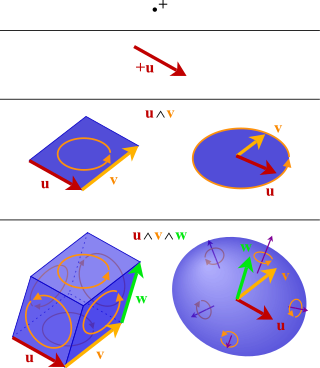Notation
The following summarizes short definitions and notations that are used in this article.
Manifold
, are -dimensional smooth manifolds, where . That is, differentiable manifolds that can be differentiated enough times for the purposes on this page.
, denote one point on each of the manifolds.
The boundary of a manifold is a manifold , which has dimension . An orientation on induces an orientation on .
We usually denote a submanifold by .
Tangent and cotangent bundles
, denote the tangent bundle and cotangent bundle, respectively, of the smooth manifold .
, denote the tangent spaces of , at the points , , respectively. denotes the cotangent space of at the point .
Sections of the tangent bundles, also known as vector fields, are typically denoted as such that at a point we have . Sections of the cotangent bundle, also known as differential 1-forms (or covector fields), are typically denoted as such that at a point we have . An alternative notation for is .
Differential k-forms
Differential -forms, which we refer to simply as -forms here, are differential forms defined on . We denote the set of all -forms as . For we usually write , , .
-forms are just scalar functions on . denotes the constant -form equal to everywhere.
Omitted elements of a sequence
When we are given inputs and a -form we denote omission of the th entry by writing
Exterior product
The exterior product is also known as the wedge product. It is denoted by . The exterior product of a -form and an -form produce a -form . It can be written using the set of all permutations of such that as
Directional derivative
The directional derivative of a 0-form along a section is a 0-form denoted
Exterior derivative
The exterior derivative is defined for all . We generally omit the subscript when it is clear from the context.
For a -form we have as the -form that gives the directional derivative, i.e., for the section we have , the directional derivative of along . [6]
For , [6]
Lie bracket
The Lie bracket of sections is defined as the unique section that satisfies
Tangent maps
If is a smooth map, then defines a tangent map from to . It is defined through curves on with derivative such that
Note that is a -form with values in .
Pull-back
If is a smooth map, then the pull-back of a -form is defined such that for any -dimensional submanifold
The pull-back can also be expressed as
Interior product
Also known as the interior derivative, the interior product given a section is a map that effectively substitutes the first input of a -form with . If and then
Metric tensor
Given a nondegenerate bilinear form on each that is continuous on , the manifold becomes a pseudo-Riemannian manifold. We denote the metric tensor , defined pointwise by . We call the signature of the metric. A Riemannian manifold has , whereas Minkowski space has .
Musical isomorphisms
The metric tensor induces duality mappings between vector fields and one-forms: these are the musical isomorphisms flat and sharp . A section corresponds to the unique one-form such that for all sections , we have:
A one-form corresponds to the unique vector field such that for all , we have:
These mappings extend via multilinearity to mappings from -vector fields to -forms and -forms to -vector fields through
Hodge star
For an n-manifold M, the Hodge star operator is a duality mapping taking a -form to an -form .
It can be defined in terms of an oriented frame for , orthonormal with respect to the given metric tensor :
Co-differential operator
The co-differential operator on an dimensional manifold is defined by
The Hodge–Dirac operator, , is a Dirac operator studied in Clifford analysis.
Oriented manifold
An -dimensional orientable manifold M is a manifold that can be equipped with a choice of an n-form that is continuous and nonzero everywhere on M.
Volume form
On an orientable manifold the canonical choice of a volume form given a metric tensor and an orientation is for any basis ordered to match the orientation.
Area form
Given a volume form and a unit normal vector we can also define an area form on the boundary
Bilinear form on k-forms
A generalization of the metric tensor, the symmetric bilinear form between two -forms , is defined pointwise on by
The -bilinear form for the space of -forms is defined by
In the case of a Riemannian manifold, each is an inner product (i.e. is positive-definite).
Lie derivative
We define the Lie derivative through Cartan's magic formula for a given section as
It describes the change of a -form along a flow associated to the section .
Laplace–Beltrami operator
The Laplacian is defined as .

















































































































































































































































